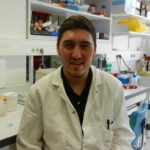Link to Pubmed [PMID] – 31832561
Link to DOI – 10.1016/j.parepi.2019.e00126
Parasite Epidemiol Control 2020 Feb; 8(): e00126
Serodiagnosis of Leishmania infantum infection in dogs relies on the detection of antibodies against leishmanial crude extracts or parasitic defined antigens. The expansion of canine leishmaniasis from geographical areas of Brazil in which the infection is endemic to regions in which the disease is emerging is occurring. This fact makes necessary the analysis of the serodiagnostic capabilities of different leishmanial preparations in distinct geographical locations. In this article sera from dogs infected with Leishmania and showing the clinical form of the disease, were collected in three distinct Brazilian States and were tested against soluble leishmanial antigens or seven parasite individual antigens produced as recombinant proteins. We show that the recognition of soluble leishmanial antigens by sera from these animals was influenced by the geographical location of the infected dogs. Efficacy of the diagnosis based on this crude parasite preparation was higher in newly endemic regions when compared with areas of high disease endemicity. We also show that the use of three of the recombinant proteins, namely parasite surface kinetoplastid membrane protein of 11 kDa (KMP-11), and two members of the P protein family (P2a and P0), can improve the degree of sensitivity without adversely affecting the specificity of the diagnostic assays for canine leishmaniasis, independently of the geographical area of residence. In addition, sera from dogs clinically healthy but infected were also assayed with some of the antigen preparations. We demonstrate that the use of these proteins can help to the serodiagnosis of Leishmania infected animals with subclinical infections. Finally, we propose a diagnostic protocol using a combination of KMP-11, P2a y P0, together with total leishmanial extracts.

